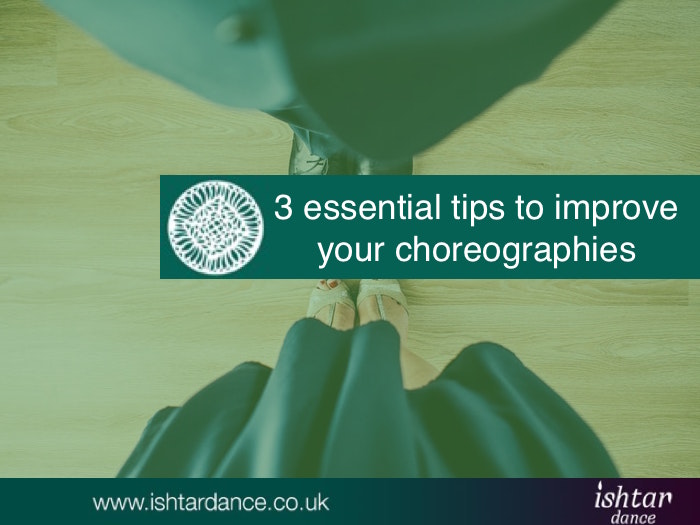Three essential tips to improve your choreographies
By Ishtar Dance on Monday, October, 9th, 2017 in Dance Coaching, Dance Inspiration, Learning, Uncategorised, Your Dance Body No Comments

Do you use choreographies or do you prefer to get up on stage and improvise? It’s often down to personal preference, but generally the more experienced and versatile a dancer you are, the more likely you are to enjoy and rely on your improvisations skills. Personally I only rarely choreograph a performance piece, but instead start out with a few lose ideas, moves and steps to get me started, and then take it from there. But even if you hate or dread improvising, it is essentially what you need to do to start pulling your choreography together, so the tips that I’m going to share with you in this article will benefit you either way.
Get up and boogie
So you’ve selected your music, you know what costume you’ll wear, now you just need to get the steps and the performance sorted. Your first step should be to dance to the music several times in a row. Nothing fancy, just get up and have a boogie. You may already have done this, when you were selecting you music, but even so, you should now do that again a few times. See which moves you produce. Are they always the same? Do you come up with something completely different every time? If so, keep going until you start getting a lose structure of moves and combinations that you like. Don’t overthink it, just go for it. If you’re lazy like me, you may want to film yourself dancing once you have this lose structure. I find it too laboursome to write lots of notes that I then can’t seem to read back or understand afterwards.
Listen, listen and listen some more
You may be surprised what your ear starts to pick up on when your continue to listen to the same tune over and over again. I remember seeing a famous dancer perform to a song that I myself was trying to string a lose choreography together to, and I noticed that she picked up on beats and accents that I hadn’t even noticed, despite knowing the track fairly well. The experience really taught me to listen with intent to any piece of music that I use. You don’t want to be dancing when you do this, and you don’t want to be doing a million other things at the same time either. Just listen…
If the song has lyrics you should also take the time to find out what they are all about. Some music, such as Egyptian Shaabi, can be quite political or full of sexual connotations, so it’s always advisable to know what it is your dancing too, especially if you will be doing so in public! You can try googling the lyrics, or see if there’s a version of the song on YouTube that has english translations. There are also online bellydance forums such as bellydanceforums.net that can be really helpful.
There are many ways to learn more about the music used in belly dancing, and often you’ll pick up a lot along the way by attending classes, workshops and doing your own research. However, as always do make sure that your sources, whether they are people or written words, are correct. If you’re serious about learning the background, history and various rhythms and styles used within belly dancing, then check out the only credited UK course on the subject delivered by JWAAD Bellydance Training. Read more here.
Work your angles
Don’t forget to make your dance dynamic and engaging by adding moves and poses on different angles. A dancer can be technically great, but if the entire dance is delivered ‘flat’, meaning only facing front and maybe to the side, it will be boring to watch. As a dancer you may also get bored with your own movement vocabulary if it’s only ever delivered in the same directions. So make sure to use not only your performance area, but also the different angles of your body.
If you’re not used to this then try experimenting with moving from facing the front to facing the back, and then onto a side angle. You don’t want to face the back for too long at the time (without looking over your shoulder), but it’s a great way to add variety and build up in a performance. Once you get more used to thinking about creating depth to your performance by turning your body, you can start exploring front and back facing diagonals too.
Different moves work on different angles, but you’ll be surprised how many moves actually work like this in different ways, so take some time exploring what a camel or a vertical figure of 8 looks like from different angles. You can also add level changes and different arms, and soon you’ll come up with movement patterns and combinations that you may have never thought of before. Filming this process might make it easier for you to see what really works and what doesn’t. Select a few of your favourites and then incorporate them into your existing structure for the dance.
I hope you found this article helpful and that you’ll discover some new exciting combinations and angles that will add some personal flair and dynamic to your next performance, no matter whether it’ll be choreographed or improvised.
Have you got any tips you’d like to share when it comes to choreographing or improvising? Have you tried any of the techniques I mentioned above? If so, did you find them useful or have you got an alternative? Please leave me a comment below so we can keep the knowledge sharing going and improve our dancing.
Happy dancing always 😉
Dorte
Did you miss my last post? Read it here: Why working with live musicians will make you a better dancer

Leave a Reply